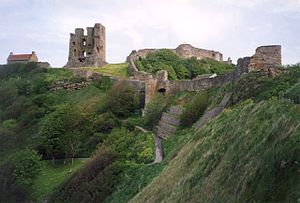| Great Siege of Scarborough Castle | |||||||
|---|---|---|---|---|---|---|---|
| Part of the First English Civil War | |||||||
 Remains of Scarborough Castle | |||||||
| |||||||
| Belligerents | |||||||
|
|
| ||||||
| Commanders and leaders | |||||||
|
Sir Hugh Cholmley William Nesfield |
John Meldrum (DOW) Sir Matthew Boynton | ||||||
| Strength | |||||||
| 500 | 1700 | ||||||
| Casualties and losses | |||||||
| c.475 killed or wounded | Unknown | ||||||
The Great Siege of Scarborough Castle[a] was a major conflict for control of one of England's most important stone fortresses during the First English Civil War fought between the Parliamentarians and the Royalists loyal to King Charles I. In February 1645, Parliamentarians laid siege to Scarborough Castle. For five months, they bombarded it, destroying most of the keep, and engaged in bloody fighting before the defenders finally surrendered.
This was a significant though not permanent victory. There was a second, far less bloody and destructive, siege later in 1648 when the new garrison switched sides. The castle finally came under Parliamentarian control in 1649, and remained so until the Restoration (1660). (The castle actually changed hands seven times between 1642 and 1648.[1])
Cite error: There are <ref group=lower-alpha> tags or {{efn}} templates on this page, but the references will not show without a {{reflist|group=lower-alpha}} template or {{notelist}} template (see the help page).
- ^ Binns 1996, pp. 73–220